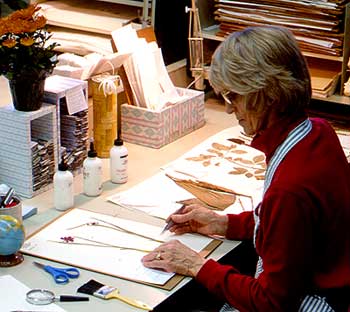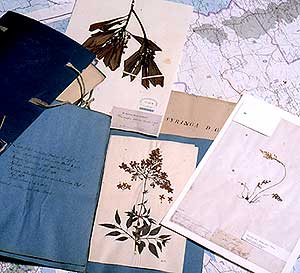 |
QUICK SEARCH
MO PROJECTS:
Africa
Asia/Pacific
Mesoamerica
North America
South America
General Taxonomy
Photo Essays
Training in Latin
America
MO RESEARCH:
Wm. L. Brown Center
Bryology
GIS
Graduate Studies
Research Experiences
for Undergraduates
Imaging Lab
Library
MBG Press
Publications
Climate Change
Catalog Fossil Plants
MO DATABASES:
W³MOST
Image Index
Rare Books
Angiosperm
Phylogeny
Res Botanica
All Databases
INFORMATION:
What's New?
People at MO
Visitor's Guide
Herbarium
Jobs & Fellowships
Symposium
Research Links
Site Map
Search
 | table of contents |
A Permanent Record of Plant Life | |
 When they arrive at the Garden, pressed plant specimens are treated in freezers to kill destructive insects. Shown: Vascular plants are sewn or glued onto stiff sheets of archival paper for permanent storage. Photo: Trent Foltz | |
|
The inner workings of the herbarium are not well known to the casual Garden visitor. But the herbarium - essentially a plant specimen library - is a cornerstone of botanical research. Botanists base much of their knowledge of plants on pressed, dried specimens that have been carefully identified, labeled, mounted, and stored in a cool, dry, insect-free environment. Once plants are filed on the herbarium shelves, researchers can quickly locate any particular specimen. And they do. In addition to Garden staff, more than 450 scholars, many from other countries, visit each year. The herbarium makes it possible to compare, side-by-side, plants that grow in different regions and analyze their characteristics. To facilitate this, the Research Division loans, receives, transfers, or exchanges over a quarter of a million specimens each year. From the beginning, the Garden's herbarium has been global in scope. It began with approximately 62,000 specimens, the collection of Johann Jakob Bernhardi, purchased in Germany in 1857 on behalf of the Garden's founder, Henry Shaw. The Bernhardi collection was formed in Germany during the 18th and early 17th centuries. It contains many valuable early specimens from North and South America, Africa, and Asia, including many type specimens - the collections on which the names of plants are based - critical reference points for subsequent studies. The purchase was made by George Engelmann, an immigrant German physician, botanist, and principal advisor to Shaw. Engelmann consulted with many expeditions to western North America and northern Mexico that passed through St. Louis during the mid-19th century, and his significant personal herbarium of about 100,000 specimens included plants collected on those historic explorations. The Engelmann Collection was donated to the Garden in 1890. Over the years, the herbarium has continually broadened and deepened its holdings. The Garden is the North American center for the study of African plants, with nearly 700,000 plants from that continent now stored on the herbarium's shelves. There are also significant holdings from Central America, western South America, and Madagascar. And with the acquisition of more than a quarter million specimens from Chinese institutions to date, the Garden has become one of the few Western centers for the study of Chinese plants. | |
 Given proper care, herbarium specimens last forever. The Garden's herbarium contains plant specimens collected by George Boehmer in the 1740's, by Joseph Banks and Daniel Solander, who accompanied Captain James Cook on his first voyage around the world (1768-71), and by Charles Darwin on his voyage with the H.M.S. Beagle (1831-36). Shown (clockwise from top): Specimens collected by Banks, Darwin, and Boehmer. Photo: Trent Foltz | |
| Text and photos from "The Unseen Garden" available from MBG Press. | |
© 1995-2025 Missouri Botanical Garden, All Rights Reserved
4344 Shaw Blvd.
St. Louis, MO 63110
(314) 577-5100
Technical Support